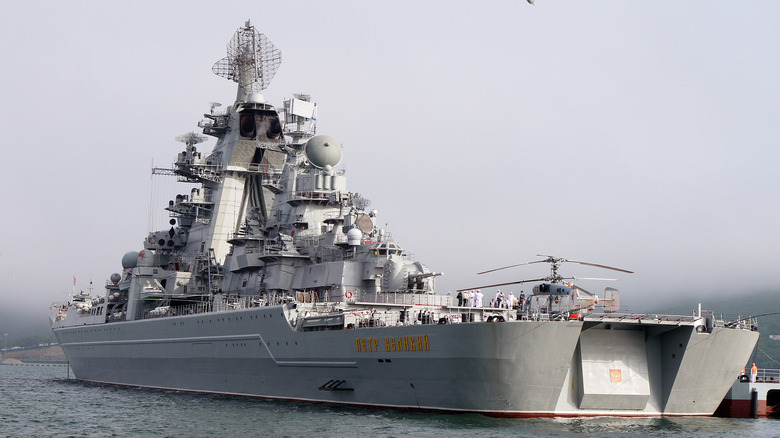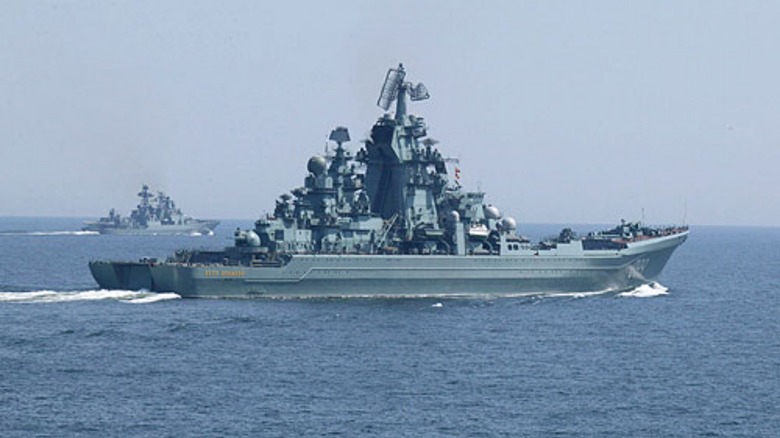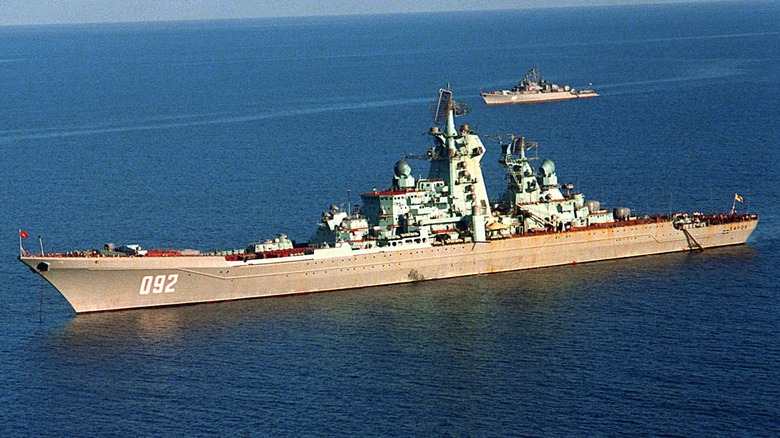Russia May Mothball Its Kirov-Class Battlecruisers: Here's Why
The Russian Navy isn't exactly the biggest and baddest around — the country only has one aircraft carrier, and it's not functional, after all. Since the country invaded Ukraine in 2022, its Black Sea fleet has dwindled from several powerful vessels to hardly any Navy presence. Still, the Russian Navy does exist, and one of its most interesting vessels, the Kirov-class battlecruiser, may be heading to the scrapyard because it's getting too expensive to maintain them.
Kirov-class battlecruisers are comparable in size to World War I-era battleships, and compared to other vessels afloat in the world's navies, they're second in size only to the biggest vessels, aircraft carriers. Kirov-class battlecruisers have been in operation since 1980, though Russia only has two remaining, one of which is undergoing a costly refit. That leaves a single vessel, the Pyotr Velikiy (Peter the Great) as the only ship of its class that sails as the flagship of the Northern Fleet.
The Admiral Nakhimov (named for Pavel Nakhimov) began an expensive refit and modernization upgrade in 2015, and it should finally re-enter service in 2024. Regardless, it seems that Russia is considering mothballing the Pyotr Velikiy, leaving only the Admiral Nakhimov in service once its refit is completed. The reason for this is due to the vessel's high operation and maintenance costs amidst the ongoing war with Ukraine. Despite not taking part in the conflict, both ships may find themselves out of service sooner than the Russian Navy planned, because its resources cannot support both vessels and the ongoing war.
Kirov-Class Battlecruiser Specs
Both of Russia's Kirov-class battlecruisers are old ships, with the Pyotr Veliky entering service in 1998, while the Admiral Nakhimov was commissioned in 1988. Despite this, they are advanced and highly capable warships. Kirov-class battlecruisers are nuclear powered, using KN-3 nuclear, marine propulsion with two GT3A-688 steam turbines for a whopping 140,000 hp. The ships are 827 feet long, they displace 28,000 tons of seawater (full load), and have a maximum speed of 37 mph.
While that's all well and good, the purpose of the battlecruisers is to counter the potential threat posed by the U.S. Navy's submarine fleet, and they're armed to the gills. Kirov-class vessels are missile cruisers, and they have many types onboard. These include various surface-to-surface missiles (SSM), surface-to-air missiles (SAM), and anti-submarine weapons (ASM). They're also outfitted with a variety of heavy guns, including anti-aircraft weapons, hypersonic anti-ship missiles, torpedoes, and more.
Because they're nuclear-powered, Kirov-class battlecruisers have an unlimited range, much like their ideal prey: submarines. Of course, with all the firepower, personnel, maintenance, and operating costs, the Kirov-class battlecruisers are too costly to keep. They've never engaged and sunk an enemy sub, so they're mainly used as a show of force. Their size is certainly intimidating, but they aren't exactly equipped with the latest technology that would place them on par with anything the U.S. currently sails.
[Featured image by Kremlin.ru via Wikimedia Commons | Cropped and scaled | CC BY 4.0]
What's next for Russia's Kirov-class battlecruisers?
While the two battlecruisers Russia has in its inventory are fierce fighting ships, they're too expensive to retain for much longer. In April 2023, Tass reported that the Pyotr Velikiy is likely to be decommissioned due to the vessel's condition and the cost of repairs to bring it up to modernization standards. Because of this, the Russian Navy will likely retire the vessel instead of refitting it to new standards, as the cost would be considerable.
That would leave only the Admiral Nakhimov in the inventory sailing in the North Fleet. According to Bulgarian Military, this reflects "the Russian Navy's Arctic region prioritization due to its emerging importance as a key trade route and geopolitical battleground. The Northern Fleet's positioning also allows the warship to contribute significantly to Russia's strategic missile defenses." While the vessel's refit took nearly a decade and likely cost a fortune, the Admiral Nakhimov has been updated to modernization standards.
The vessel has been outfitted with new electronics, sensors, an air-defense system with a 250-mile radius, and 96 cells devoted to its SAM systems. The ship's cruise missile complement got an upgrade, and its firepower has been significantly increased. While this makes the Admiral Nakhimov one of the deadliest surface vessels operating in the Northern Fleet's area of operation (AO), the high cost of continued operation may continue to limit its service, and it wouldn't be too surprising if the last Kirov-class battlecruiser was retired sooner rather than later.
[Featured image by U.S. Navy via Wikimedia Commons | Cropped and scaled | Public Domain]


